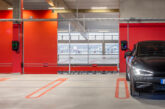
The team at ABB talk us through how to install an ABB Terra DC Wallbox.
Preparing the site
The first job in any project is planning and preparation of the site. That starts with a site visit to confirm the location and available capacity of the distribution board and plan the cable route to the EV charging place.
It is also necessary to apply for a permit or to inform the local Distribution Network Operator of the plans. This requirement was initiated by the Energy Networks Association in February 2019 to help utilities plan and meet demand.
DC wallboxes rely on data communication to manage payments and for remote monitoring, so an internet connection is also essential. The Terra DC Wallbox has its own wireless 2/3G modem that comes with a SIM card pre-loaded by ABB. For sites with no wireless signal, such as underground car parks, a standard wired connection will be needed.
Mounting requirements
It is important to identify a suitable location for mounting the wallbox. The Terra DC Wallbox requires a minimum space of 900 x 1,200mm, including space for clearance around the unit, as well as ventilation and cooling air flows. For outdoor sites, provision should be made to prevent snow or other blockages building up over the vents on the top and bottom of the unit.
The charge cables of the Terra DC Wallbox reach from 3.5 to 7 metres long, so it is important for the owner of the site to plan the arrangement of parking bays carefully. If you’re not careful, you might end up with cables that don’t reach charging points – and frustrated drivers. To avoid this, ABB’s installation manual includes detailed diagrams with suggested alignment for parking bays.
Choosing the right unit
When you’re ready to order the wallbox, it’s worth remembering that most customers will want outputs for both CCS and CHAdeMO vehicles. However, some car dealerships may want either one or the other of these.
For customers in the UK, the Terra DC Wallbox European should be chosen. It contains contact blocks for connection to a three-phase and neutral supply. Another important point when ordering the hardware is that the contractor should allow for external RCDs.
The Terra DC Wallbox provides fast charging at 24 kW and is designed for drivers to get a decent top up within 1-3 hours and get back on the road – perfect for a commercial site.
Installation
Installation can take place when the wall preparation is complete, all necessary permits have been secured and a grid connection is available and as with any project, the contractor should follow the wiring regulations and safety guidelines.
ABB’s installation manual includes detailed guidance on how to check the condition of the unit upon delivery, as well as how to unpack and prepare the unit for mounting, connection and configuration.
Commissioning and operation
The final phase of an installation project is commissioning, which must be performed by a certified service engineer. The engineer will need to register the wallbox with the ABB helpdesk – this process takes anywhere between half an hour and an hour.
This can be done remotely, but a number of conditions must be met first, including the availability of power and internet access, the presence of a local technician for assistance and to switch on the power, and CCS and/or CHAdeMO vehicles for testing. Once registered, the engineer can view the unit on the system, set the upstream fuse size, enter a contact name for the owner of the unit and perform a test charge.
The engineer will also need the name and location co-ordinates for the site, as they will add the charger to ABB’s monitoring system. This ensures that ABB can provide support by diagnosing issues, recommending maintenance and providing support from its remote centre throughout the life of the unit.
To download a DC Wallbox product leaflect, click here.









